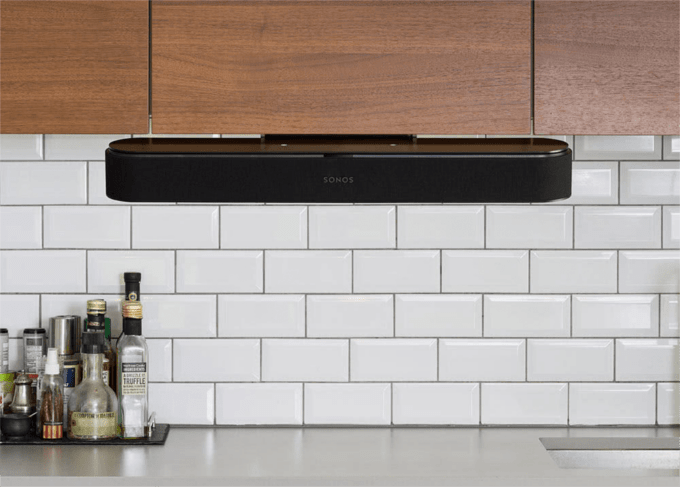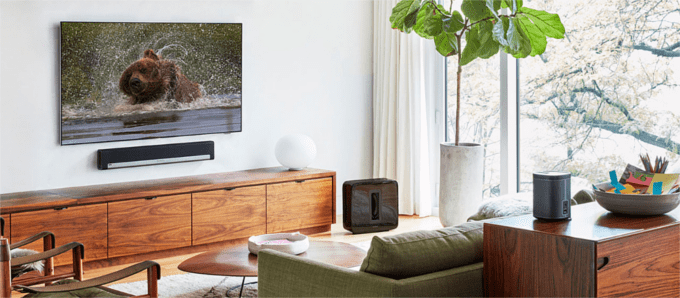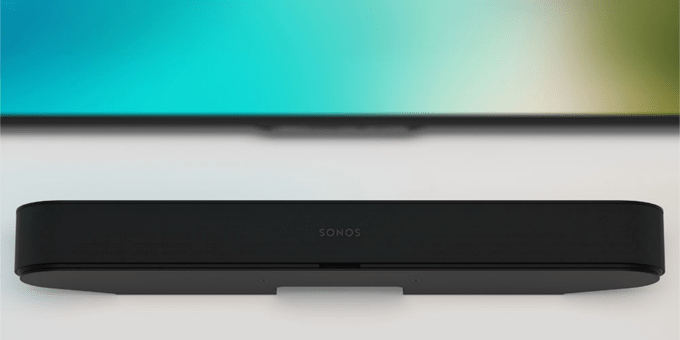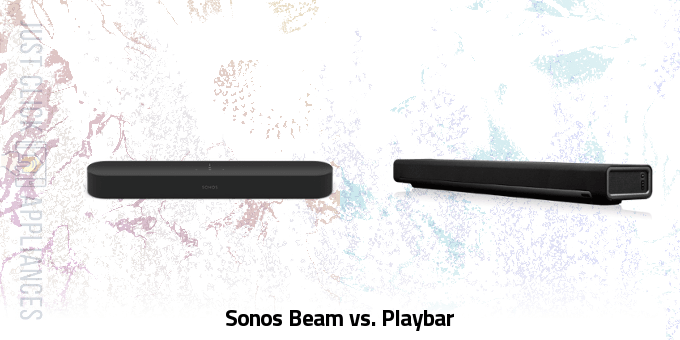The Sonos Beam and Playbar represent some of the best soundbars on the market. Whether you’re looking for a boost to your home theater system or a way to fill the room with your favorite playlists and podcasts, both smart speakers have a lot going for them.
The Sonos Beam is the perfect fit for filling small spaces with a big sound, and the booming bass of the Playbar will expand to fit the largest rooms in your home.
Let’s compare the Sonos Beam vs. Playbar to figure out which device is the better buy when it comes time to add a smart speaker to your audio arsenal.
Sonos Beam vs. Playbar — Differences
Difference #1: Sound Quality – While these two devices may accomplish the same goals, there is a significant difference in sound quality between the Sonos Beam and Playbar just based off of the internal audio equipment responsible for producing rich, dynamic audio.
The Sonos Beam features a single tweeter and four mid-woofers, each backed up by its own dedicated amplifier. This produces some high-quality sound that edges out a lot of the competition, but the speaker fails to compete with the superior acoustics of the Playbar.
With three tweeters, six mid-woofers, and 9 digital amplifiers, the Playbar is the clear winner when it comes to sound.
Both devices should make an excellent addition to your home theater, but for those who place audio fidelity as a top priority, the Playbar is our pick.
Difference #2: Connects to TV – As mentioned above, both the Sonos Beam and the Playbar attach to your TV to amplify the sound as part of a home theater system. However, they do connect via different methods that make the installation process either easier or more a little bit more complex.
Setting up the Playbar is the easiest of the two; just plug it in via the optical cord — no need to even read a manual.
The Sonos Beam connects via the TV HDMI-ARC port. The majority of TVs have two to four HDMI ports, with one of them labeled ARC, short for Audio Return Channel. This is a special HDMI port that syncs the audio and picture, and it will automatically pair your TV remote to the Sonos Beam. The HDMI-ARC port should be labeled, but if you can’t find it it might be a good idea to contact your TV’s manufacturer.
Keep in mind that if your TV is older than 5 years it’s likely the HDMI-ARC port will be absent, and there are a number of modern HDTVs that don’t support the channel either. If you don’t have access to that specific port, you can use the included optical audio adapter to connect the Sonos Beam to your TV — just recognize that the Amazon Alexa TV voice commands will not work when you connect via this adapter.
Difference #3: Voice Control – As mentioned above, both the Playbar and the Sonos Beam can be controlled via Amazon Alexa. They do differ, however, in how they interface with the virtual assistant.
The Playbar is controlled through Amazon devices like the Amazon Echo or Echo dot, which means that you’ll need that external equipment in order to take advantage of voice controls.
With the Sonos Beam, however, Amazon Alexa is built into the device. It’s important to note that this functionality means that the Beam is always listening to your speech in order to respond to any voice commands. However, the speaker does come with a handy mute button in order to turn off the listening and address any privacy concerns. An illuminated LED indicator light always tells you when the speaker’s microphone is active, so you can be well aware of when the smart speaker is listening in.
Another noteworthy feature of the Sonos Beam is its support for AirPlay 2, which means you’ll have access to control with Siri-enabled device like the iPhone or iPad.
Difference #4: On-Device Control – While the primary way to control the smart speakers is through the dedicated app, both the Sonos Playbar and Beam include support for on-device controls.
With the Beam, you can take advantage of capacitive touch controls for volume, play/pause pause, microphone mute, and moving tracks forward or backward. An LED indicates the speaker’s status, mute status, and voice feedback as well.
The Sonos Playbar has side panel buttons in order to control the volume and play or pause your music. The buttons lack a touch interface, but that adds to a sleeker aesthetic overall when compared to the Beam.
Difference #5: Bluetooth LE – Bluetooth Low Energy is a technology that allows your devices to communicate over Bluetooth — a feature which spends less power than streaming data over WiFi.
The Sonos Beam supports Bluetooth Low Energy technology, but the feature is only used to temporarily communicate with your phone or tablet during the setup process. The day-to-day usage requires WiFi in order to function.
The Playbar does not use Bluetooth Low Energy at all.
Difference #6: Ethernet Port – Both the Sonos Beam and Playbar include support for Ethernet connections, but the Beam only has one whereas the Playbar comes with two 10/100 Mbps Ethernet port.
You may be wondering why exactly you would need two ethernet ports on one smart speaker, but the extra port actually comes in handy. You can use one port to connect your speaker to a wired home network, and the other to bring internet connectivity to other devices — effectively allowing the Playbar to function as a hub on its own. This allows you to easily connect a Smart TV or Roku box to your LAN and the Internet for smooth and uninterrupted streaming of your favorite shows.
Difference #7: Design – The Sonos Beam and Playbar are similar in design at a base level, with both being long and short due to their construction as soundbars. They do differ significantly in size, however, with the Playbar coming in at nearly 12 pounds with the Sonos Beam significantly lighter at just over 6.
The Sonos Beam also offers more choice when it comes to finish, with both Black and White color options, while the Playbar is limited to Black.
There are also some differences in how easy it is to place the different speakers. With the Sonos Beam, you can place it on a TV stand or purchase a custom-designed wall mount to easily and securely hang it. The Playbar fits in beautifully underneath your TV, on a table, or on a console. It also has the ability for a wall mount, giving you more flexibility overall when compared to the Beam.
Sonos Beam vs. Playbar — Comparison Chart
| Sonos Playbar | Sonos Beam | |
|---|---|---|
| Stereo Output | Yes | Yes |
| Class-D Digital Amplifiers | 9 | 5 |
| Tweeter | 3 | 1 |
| Mid-Woofer | 6 | 4 |
| Adjustable Bass & Treble Controls | Yes | Yes |
| Audio line-in | No | No |
| Connect to TV | Via Digital Optical Cable | Via Digital Optical Cable or HDMI ARC |
| Voice Control over Amazon Alexa | Yes | Yes |
| Amazon Alexa Built-In | No | Yes |
| Support Airplay 2 | No | Yes |
| Trueplay | Yes | Yes |
| Humidity Resistant | No | No |
| WiFi | 802.11b/g, 2.4 GHz | 802.11b/g, 2.4 GHz |
| Bluetooth LE | No | Yes |
| Ethernet Port | 2 | 1 |
| Size | Big | Medium |
| Dimensions | 3.35 x 35.43 x 5.51 in. (85 x 900 x 140 mm) |
2.70 x 25.625 x 3.94 in. (68.5 x 651 x 100 mm) |
| Weight | 11.9 lbs. (5.4kg) | 6.2 lbs (2.8 kg) |
| Product finish | Black | Black or White |
| On-Device Control | Buttons | Touch |
| One App Control | Yes | Yes |
| IR Control | Yes | Yes |
| Dialog enhancement | Yes | Yes |
| Night mode | Yes | Yes |
Sonos Beam vs. Playbar — Things in Common

Stereo Output – Both the Sonos Beam and Playbar feature stereo output. This sound format uses multiple channels in order to produce a well-rounded sound that fills the room.
Adjustable Bass & Treble Controls – As with most Sonos smart speakers, both the Beam and Playbar offer customizable Bass and Treble controls. This allows you to tweak things to your personal preferences and ensure that you’re getting a sound that you’re happy with and that is suited to the space you’re in.
Simple to set up – Both the Sonos Beam and Playbar have a simple setup process that makes it easy to get things started right out of the box. Each speaker supports 802.11b/g wireless standards at 2.4 GHz frequency, and you can use this wireless connection in order to set up your Sonos speakers using the Sonos app.
Trueplay – One feature unique to Sonos smart speakers is Trueplay. This feature will automatically adjust the audio settings in order to fill the room you’re in with personalized, high-fidelity audio. While both the Sonos Beam and Playbar function quite well right out of the box, variations in room composition can change the type of sound you’ll get from each device.
Trueplay takes the guesswork out of speaker configuration and makes it possible for anyone to enjoy top-quality audio.
One App Control – The Sonos Beam and Playbar each support over 80 streaming services globally, which means you’ll have access to your favorite music across pretty much any online streaming service you can think of. One of the main benefits of Sonos smart speakers that sets them apart from the competition, however, is the idea of “One App Control.” This feature allows you to access all of your content from one simple app – no more swapping between services in order to find the music you want, with everything now available in one convenient location.
Connects to TV – Both of these speakers are soundbars, so it makes sense that they would connect to your TV. It’s important to note that they differ in the way that they connect, which we’ll discuss in further detail below, but rest assured that you should be able to enjoy watching Netflix with enhanced sound with either the Sonos Beam or Playbar.
Dialog Enhancement – As speakers that are designed to be used with television sets, the Sonos Beam and Playbar each come with features that allow you to enhance a show’s dialog. With built-in features that make it easier to discern what people are saying, you should no longer have to worry about important details being lost in a sea of other noise. It’s a useful feature that make these speakers as useful for TV as they are for streaming playlists from Pandora or Spotify.
Night Mode – Sometimes you’ll want to listen to music or watch TV while everyone else is already in bed, and the Night Mode included with both speakers allows you to enjoy your favorite content without disturbing those around you. By enhancing quiet noise and toning down any loud sounds, you can still listen to the full experience without waking up the whole house.
IR Control – With all the different techniques we’re using to watch media, the number of remotes can quickly get out of hand. Between a TV, Cable Box, and streaming stick, there can be a bunch of remotes to juggle that make accessing your favorite content an annoying ordeal. Both the Sonos Beam and Playbar feature IR control, which means you should be able to control them with nearly any traditional remote.
Sonos Beam and Playbar Integration

Both the Sonos Beam and Playbar provide top-quality audio on their own, but they can be expanded with other Sonos products to provide a full 3.1 or 5.1 home theater sound system. Just take a look at the extension options on Amazon for either the Sonos Beam or Playbar that will allow you to take your sound system to the next level.
In addition to the ability to expand into a fully-featured sound system, the Sonos Beam and Playbar also integrate with a number of other smart products from Sonos Partners. The idea is that you should be able to control all of your smart products through a single app, and the company will give you that capability provided the rest of your smart home is built of compatible products.
The Sonos Beam is especially easy to get connected to your smart home or home automation systems due to its ability to control devices through skills in the Alexa app. Additionally, Sonos has partnerships with smart home systems like Wink and Lutron that should even give your smart speaker the ability to respond to commands like “Set temperature to 71” and “Turn Living Room lights on.”
Also, the Sonos Beam and Playbar interface perfectly with over 50 music services — allowing you to bring your favorite tunes into your home from one convenient app.
Sonos Beam and Playbar Accessories

Both the Sonos Beam and Playbar will work well sitting under your TV, but there also some mounts that you can buy in order to get them set up the way you’d like.
With the Beam or Playbar wall mount, you can get your bar up off the floor or shelf and save precious space while keeping that same booming audio these smart speakers provide.
In addition to these mounting options, both the Sonos Beam and Playbar offer support for Sonos Boost — a device that provides the speakers with their own network and extends your WiFi coverage in order to provide uninterrupted streaming, 24/7.
Sonos Beam vs. Playbar — Our Thoughts

The Sonos Beam and Playbar are both excellent smart speakers that serve their own niche. There are very few drawbacks to either device, but they are better suited for different types of situations.
You’ll likely be happy with your purchase regardless of your choice due to utilities like Trueplay that can adjust audio as needed to suit the room. Hower, we recommend the Sonos Beam for smaller rooms due to its compact design that can fit almost anywhere, and the Playbar for louder sound with more width and bass to fill large spaces.
Last update on 2024-04-26 at 06:07 / Affiliate links / Images from Amazon Product Advertising API





